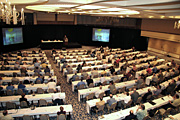Cool Roofing: Cutting Through the Glare

The Roof Consultants Institute Foundation (RCIF), Oak Ridge National Laboratory (ORNL), and the National Research Council Canada (NRCC) staged the symposium, titled "Cool Roofing: Cutting Through the Glare" to address the pros and cons of cool roofing.
The symposium featured presentations by a wide variety of experts in the field of roofing and building materials and systems. The focus of the symposium took in more than just "cool roofing." Presenters covered a variety of topics surrounding the entire issue of how roofing systems may improve overall building performance, particularly in the areas of energy conservation and urban heat island mitigation.
Over 20 separate presentations covered a broad range of topics relating to cool roofing, urban heat island mitigation technologies, materials composition and testing, and system design. Like most areas of building system and materials design, there are any number of opinions as to which is the most efficient. This symposium may not have resulted in firm answers as to which systems solve these issues, but did a great job of covering all aspects of the argument(s).
The concept of a roofing system in terms of its effect on the cost of heating and cooling the structure in addition to life expectancy issues brings about the need for a more comprehensive cost-benefit picture. Add to that the prospect of emerging requirements that roofing systems contribute to improved or more cost-efficient storm water management and urban heat island mitigation, and the pace of discussion picks up considerably.
What follows are just a couple of highlights of the presentations that will be of interest to roofing contractors.
Government Initiatives
Many of the presenters made reference to several of the more significant initiatives by local, state and federal governments. Cool roof initiatives are expected to spread from jurisdiction to jurisdiction. The Chicago Energy Code is thought to have provoked change in a number of other major cities, and the coming updates to Title 24 in California are expected to be a bellwether for other states.
Government Initiatives
Many of the presenters made reference to several of the more significant initiatives by local, state and federal governments. Cool roof initiatives are expected to spread from jurisdiction to jurisdiction. The Chicago Energy Code is thought to have provoked change in a number of other major cities, and the coming updates to Title 24 in California are expected to be a bellwether for other states.Materials Technology
Improvements in polymer technologies continue to manifest themselves in roof coatings products. Advances in pigments have contributed greatly to the reflective properties of metal roof coatings and are impacting other materials. It is possible with these pigments to achieve high reflectivity ratings, even with darker colors.Design Considerations
Use of highly reflective roof surfaces is not a good thing in every situation. The pros and cons of reflective roofs in the urban setting were fleshed out with examples of bright white roofs that created havoc for surrounding structures. It was pointed out that design considerations should be considered "local" and that there will not be a single solution adaptable in every situation. Considerable argument still exists over the use of reflective membrane systems in northern states that have very short cooling seasons and long heating seasons. Those arguments go on.Keeping It Cool
Aged-reflectivity values presented an interesting topic of discussion in several of the presentations. The prospects of cleaning a roof to maintain an acceptable level of reflectivity were discussed at length. There was some agreement based on field-testing that cleaning a roof did restore a significant percentage of the original reflectivity. In dispute was the value of performing the cleaning vs. the resulting energy savings. The answers lie in a region-for-region basis, or perhaps even building-by-building.Chest Pounding
Several of the presentations were set to put forward a particular system or line of goods. A few subtle commercial messages are evident in the white papers published along with the presentations. Of course that is completely acceptable in our economic system. This cast of characters, to their credit, does a good job of matching their claims to testing. However, many of the standards for testing in this particular field are still under discussion or review. The Cool Roof Ratings Council's rating system is enjoying increasing acceptance as the "gold standard" thanks in part to its adoption by California Title 24. It should be noted that there are other materials that may legitimately claim to be "cool" that are not reflective enough to meet the CRRC or Energy Star ratings, such as clay and concrete roofing or ballast used in single-ply roofing systems.Continuing Studies
Some of the presentations cited statistics based on work that was admittedly incomplete due to the nature of long-term testing. In a business where life expectancy of materials ranges from 10 to 50 (or more) years, it is natural to have testing ongoing at all times. A number of (relatively) new tests being conducted will yield results in the coming years that will no doubt have an impact on emerging changes to codes relating to energy-efficient roofing.
While most of the information presented in this symposium was geared to commercial buildings, it is clear that there is growing interest in cool roofing solutions for the residential/steep-slope side of the industry. Some of the demand drivers on that side of the business are not as pronounced as they are in commercial construction.
The organizations behind "Cool Roofing: Cutting Through the Glare"-RCIF, ORNL and NRCC-are to be congratulated for this important piece of work. We expect they will begin work now preparing for the next round of presentations as requirements for more efficient and sustainable building systems continue to build.
Looking for a reprint of this article?
From high-res PDFs to custom plaques, order your copy today!






